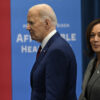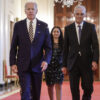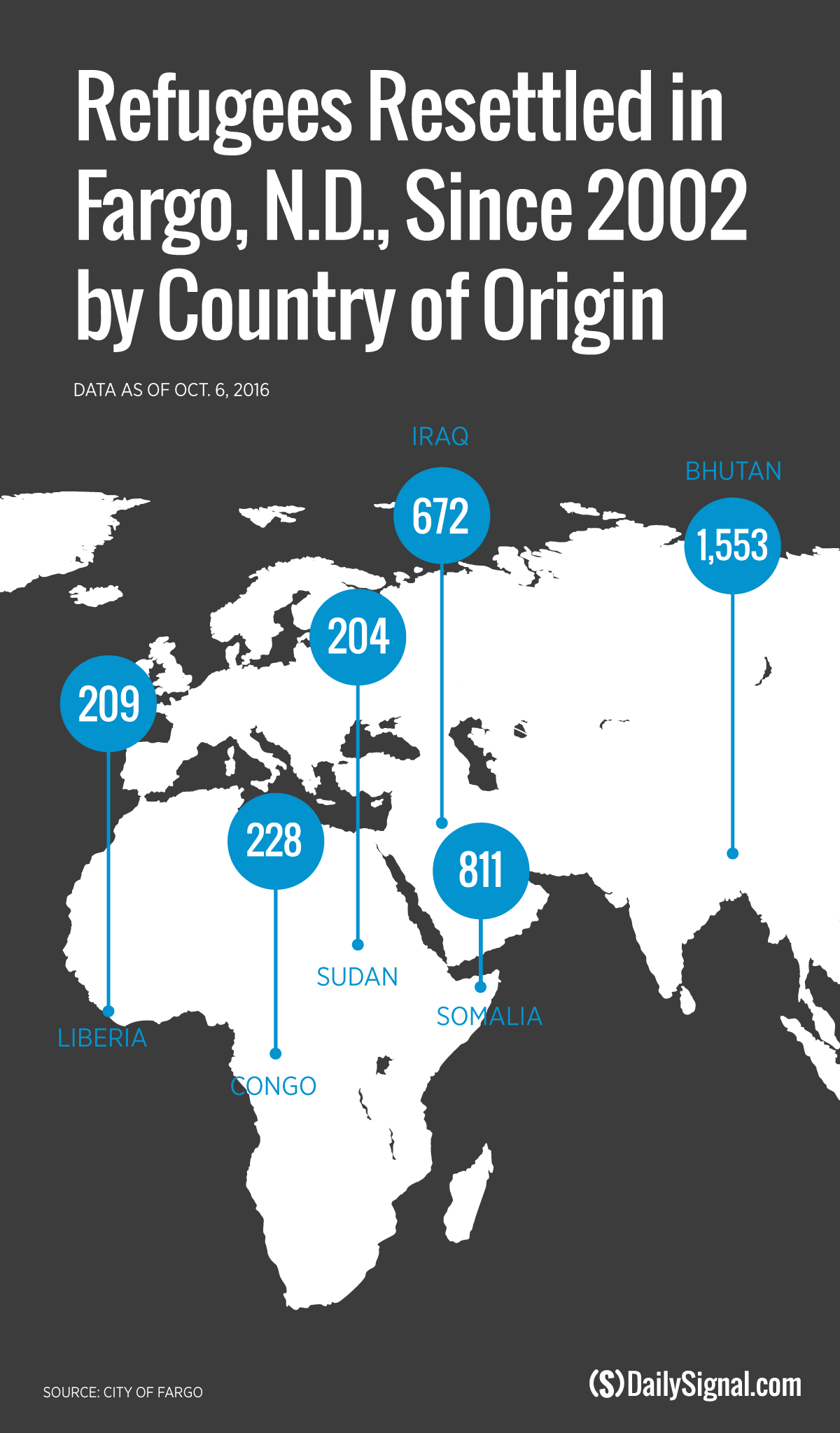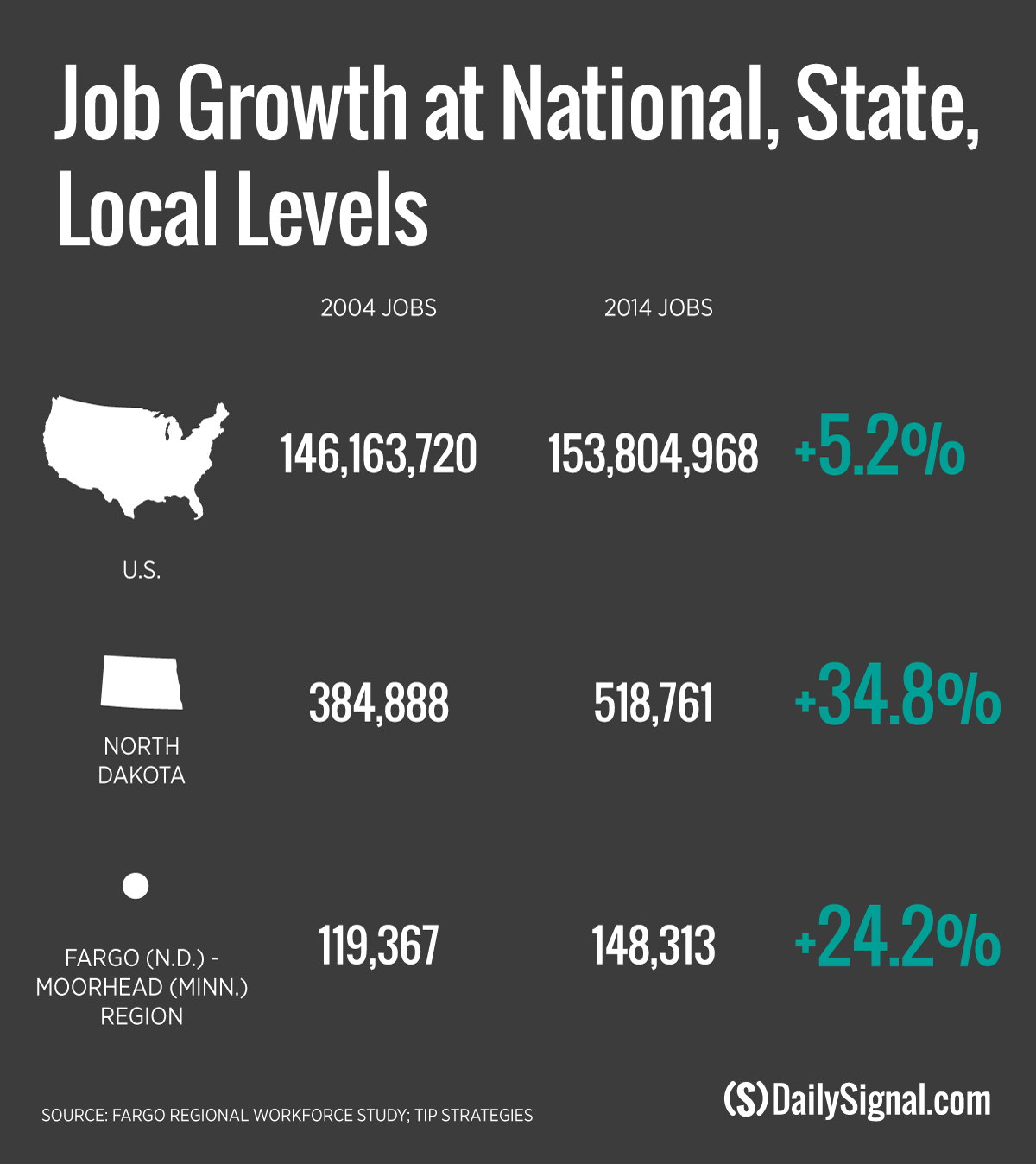Greg Haney is able to capture the change happening in the largest city of this small state better than most.
Haney shoots school photographs for his father’s 39-year-old local company, chronicling increasingly diverse student bodies that span Fargo, North Dakota, and Moorhead, Minnesota, twin cities in bordering states separated only by the Red River.
Haney is a Republican-leaning, Breitbart-reading veteran of the Navy, born and raised in Moorhead, but residing since 2003 in a house he owns in Fargo.
He came to appreciate cultural differences during his tours in the Navy, and he can just as easily translate “how are you” into Arabic as he can exclaim the uniquely folksy word “jeepers” in everyday conversation.
“This area seems to act together as cities and states first, and that goes to both sides of the river,” Haney, 43, tells The Daily Signal in a recent phone interview, adding:
We don’t concern ourselves as much with what the rest of the country is doing. So when I see refugees and immigrants coming to this area, I don’t get caught up in the rhetoric. I think of them as equals because they have the same freedoms I do. You have to live, you have to work, you bear children, and your child will have the same rights as mine.
Haney’s pictures serve as a lens through which to see the diversification happening over time here—and accelerating since the oil boom—in a place that is far from the nation’s borders, but intimately a part of the nationwide debate occurring over immigration—both legal and illegal—and refugees.
From 2010 to 2014, North Dakota’s population of immigrants, including legal and illegal, increased at a larger percentage rate—45 percent—than any other state in the country.
Over the fiscal years 2014 and 2015, no other state took in more refugees per capita than North Dakota, with about 80 percent of those making their home in the state’s largest county, Cass, which includes the state’s most populous city, Fargo.
While the absolute number of immigrants and refugees moving to North Dakota—a state with less than 1 million residents—is far less than bigger, more traditionally diverse states such as California and Texas, the change occurring is significant. And, according to local officials, not by accident.
Though North Dakota has a long history of resettling refugees, the pace of that effort, and of immigration through other means, promises to increase in the coming years, especially in a city like Fargo that’s starving for workers to serve its booming job market.
“In order for our economy to survive in the 21st century, we have to become a multidimensional city,” Fargo Mayor Tim Mahoney says in an interview with The Daily Signal, ticking off job opportunities in health care, hospitality, and technology—including at Fargo’s Microsoft campus, the company’s second-largest hub in the country.
“Millennials who are increasingly working in these jobs like to have a multicultural area that has differences in people,” Mahoney says. “We really need a diverse population to be more like a normal American city.”
“We really need a diverse population to be more like a normal American city,” says @cityoffargo Mayor Tim Mahoney.
Tensions Rise
During its transition to “normal,” Fargo has experienced tensions that have defined the national conversation, especially surrounding the issue of refugee resettlement.
North Dakota Gov. Jack Dalrymple, a Republican, is one of more than half of the nation’s governors who have called for the Obama administration to halt the resettlement of refugees from war-torn Syria until the government improves vetting procedures to their liking.
The state’s at-large member of the House of Representatives, Republican Kevin Cramer, co-sponsored legislation that would give Congress final approval over the number of refugees the executive branch decides to resettle each year.
“To me, this is about good old Midwestern common sense,” Cramer tells The Daily Signal in an interview. “There are two main things we ought to be concerned about. One is the cost, and the fact that regardless of how compassionate states and local communities may be, the local residents don’t get a say in that. And the other concern is public safety.”
The congressman adds:
I am not advocating Fargo, and North Dakota, stop taking refugees. By and large refugee resettlement has been a real success story here. But as the demand grows, we should be more diligent, and someone in government ought to have something to say about the numbers.
Meanwhile, more than 3,000 people have signed on to a Change.org petition asking for a moratorium on refugee resettlement to Fargo. And a Fargo city councilman, Dave Piepkorn, has demanded the city’s leaders reveal the financial cost of resettling refugees.
“Regardless of how compassionate states and local communities may be, the local residents don’t get a say in that,” says @RepKevinCramer.
Piepkorn, in an interview with The Daily Signal, declares himself a supporter of robust immigration and a product of immigrant grandparents from Norway. But he says he’s worried that terrorists will try to infiltrate the nation’s refugee resettlement system.
Piepkorn notes that a 20-year-old Somali man suspected in a September stabbing attack at a mall in St. Cloud, Minnesota, originally settled in Fargo with his family in the mid-1990s before they moved to Minnesota.
He says elected officials—and local taxpayers—like himself should have a say in determining the city’s commitment to resettling refugees.
“We have a shortage of workers, and from that side we love having immigrants come here,” Piepkorn says, adding:
The majority are very productive and help out the city. But as a fiscally conservative commissioner, my job is to make sure the city is spending its money carefully. We want to know how much [refugee resettlement] costs us, and it should be up to us, as elected officials, to determine who is coming. To have us not know what is going on here is unacceptable.
‘Being There for Your Neighbor’
A nonprofit faith group, Lutheran Social Services of North Dakota, is the driver of the state’s rich legacy of helping refugees.
Assisting foreign-born individuals escaping persecution is only a part of the mission of this “social ministry,” which also helps locals find affordable housing and assists in providing services from disaster recovery to therapy.
Yet the refugee component of its work has drawn the most attention, especially because Lutheran Social Services is the only resettlement agency in North Dakota. Working with national volunteer agencies, the ministry determines the capacity of North Dakota and its cities to absorb refugees.
Jessica Thomasson, the CEO of Lutheran Social Services, says her organization’s outreach to refugees is born from generosity, and an understanding that North Dakota, especially Fargo, has the infrastructure—jobs, family ties, and a diverse Muslim population—to accommodate immigrants and be a place where they can thrive.
“Certainty we live in a complicated time, and there’s a lot of information to take in nationally and around the world that is causing a lot of people to self-examine and ask questions,” Thomasson tells The Daily Signal in an interview. “But I really believe helping people in need, and being there for your neighbor, are American values and part of who we are as a country.”
Thomasson says North Dakota’s dedication to assisting refugees is nothing new, and its success in integrating them into wider society is relatively seamless.
She says her nonprofit aims to resettle about 450 refugees annually, but that number has neared 500 in recent years. Since January 2002, a total of 3,677 refugees have come to live in Fargo as of Oct. 6, most of them from Bhutan, a small Buddhist kingdom in South Asia.
Fargo also has resettled large numbers of refugees from Somalia and Iraq, two countries plagued by terrorism. Thomasson says only one Syrian family has found refuge in North Dakota, but she expects more to come from that Middle East country as the war there continues.
About 90 percent of refugees arriving in North Dakota already have family living in the state, Thomasson says, providing a support structure that helps fulfill the ultimate goal of her agency—to facilitate self-sufficiency.
Lutheran Social Services distributes two forms of grant money from the federal government to refugees in North Dakota. Each individual refugee gets a one-time startup grant of $1,125 to fund initial needs such as a deposit for housing, clothing, kitchen supplies, and furniture.
The refugees, for a maximum of eight months, also receive monthly cash assistance—$335 for an individual or $685 per four-person family. Once a refugee finds work and can cover expenses, the monthly payments stop, even if that occurs in less than eight months. Thomasson says most refugees in North Dakota can support themselves after three to four months.
Refugees emigrate to the U.S. with varying skill sets, and North Dakota’s economy caters to both the low- and high-skilled ends of the spectrum. Thomasson says refugees tend to work in the hospitality, restaurant, retail, and manufacturing industries.
A June 2015 study conducted by TIP Strategies and cited by city staff found that the number of new jobs in the Fargo-Moorhead region increased by 24 percent from 2004 to 2014. The region has more than 5,000 job openings, and is projected to have more than 30,000 in the next five years.
Opportunities exist for whoever wants to work hard, city officials say, no matter if they are native- or foreign-born. In fact, international migration to Fargo—and wider North Dakota—pales in comparison to domestic immigration. The trend accelerated in 2008 as part of the oil boom, when people from other states arrived to work in that industry and in supporting jobs in hospitality, homebuilding, and food services.
Kevin Iverson, manager of North Dakota’s Census Office, says 1 in 6 jobs in 2014 were held by people from other states—or countries.
“The reality is people come to North Dakota for work,” Iverson says in an interview with The Daily Signal. “The motivating factors to be here are the right ones.”
A Refugee’s Story
Maryam Mohammed, a recent arrival in Fargo-Moorhead from Iraqi Kurdistan, is eager for her piece of the American dream.
In February, Mohammed, 23, was the first in her immediate family to arrive as a refugee, leaving behind her parents and four younger brothers, who are awaiting action on their own applications.
Though Mohammed was not directly threatened by terrorists of the Islamic State, or ISIS, in the city of Zakho where she lived, she says their destruction wasn’t far away, and she personally knew some of their victims. Home also offered few job opportunities for a young woman like herself.
So Mohammed lives in the Fargo-Moorhead area with an aunt. Her father’s sister moved there with her husband and children as refugees from Iraqi Kurdistan 18 years ago.
Mohammed speaks with The Daily Signal in her native Kurdish language through a translator, her 22-year-old first cousin Fatima Amedi.
Amedi is an American citizen and has known Fargo-Moorhead to be her home since she was 3 years old. She is trying to assist Mohammed in navigating all that is new—helping her cousin to purchase a winter coat for the first time, to appreciate the pop music of Adele, and to apply for jobs.
Mohammed, who graduated high school before leaving Iraq, aspires to be a teacher. For now, while she takes English classes, she figures she can work at Wal-Mart, stocking shelves in the back until she has the skills to interact with customers. She has applied to work there but has not heard back.
“I don’t think refugees should be seen as different than anybody else,” Mohammed says. “They come here to make a better life for themselves. They don’t cheat. They just try to make an honest living like anybody else.”
If Mohammed got the Wal-Mart job, or one similar to it, she would be following the path of Amedi, who worked her way up to become a manager of a grocery store and no longer endures curious comments about the hijab she wears over her hair.
‘We Have the Same Problems’
To adjust to a new culture and city—Mohammed had never heard of Moorhead before she arrived there—she relies on things that make her comfortable, like her Muslim faith.
Mohammed, staying with her aunt, and Amedi, married and residing with her husband, live in Moorhead but spend much of their time across the Minnesota border in Fargo.
There they find the familiar in the region’s only mosque, the Islamic Center of Fargo-Moorhead.
Mohammed is teaching Sunday school there, among many worshipers who came to the region as refugees from different parts of the world.
“It’s nice to know I am not alone,” Mohammed says.
Dr. Mohammed Sanaullah is one of the mosque’s trustees. A physician and American citizen living in Fargo who emigrated to America from India 13 years ago, Sanaullah seeks to help refugees like Mohammed reconcile their dedication to faith with their new culture.
Sanaullah, in an interview with The Daily Signal, says of the 4,000 to 5,000 Muslims who attend his mosque, the majority arrived in the region as refugees. He acknowledges some of the local skepticism about new arrivals from overseas, and says the mosque is hosting more interfaith events, so people of other religions can learn about Islam and interact with refugees.
“We have the same problems like any other church or community would have,” Sanaullah says. “The same problems affect our children, like them getting too much into video games, and we worry about maintaining our family values.” He adds:
What we are telling people who attend the mosque is, city leadership is on our side, the police is on our side, and if you work harder, and do what you are doing better, that will reflect on you and your boss will say, ‘Thank God we took in a refugee.’ People will see you for your value and your work and appreciate you for that. You can live the American dream—even in a small town like Fargo, North Dakota.
































